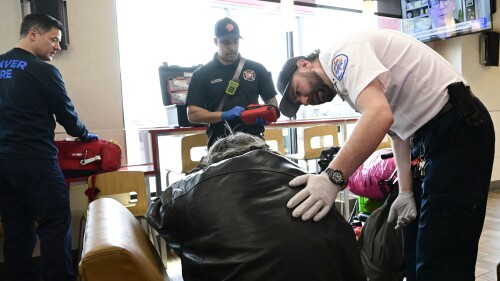By Jim Lockwood
The Times-Tribune
SCRANTON, Pa. — Scranton is considering creating an ambulance service within the city Fire Department, to achieve faster response times to life-threatening 911 medical calls and better serve residents, officials said.
With the city served by one ambulance service, the private Pennsylvania Ambulance LLC, the administration of Mayor Paige Gebhardt Cognetti hired a consultant with expertise in public safety and health care, Fitch & Associates of Platte City, Missouri, to conduct an “Emergency Medical Services Feasibility Study” for the city.
Fire Chief John Judge, Dr. Kirk Hinkley, who is the medical director of the Fire Department’s EMS program, and Steven Knight, a Fitch partner who leads the firm’s fire service practice that often deals with assessments, standards and planning, explained the feasibility study to Scranton City Council during a council caucus Oct. 22, according to an Electric City Television simulcast and video of the session posted on ECTV’s YouTube channel.
City officials started in 2020 talking about the EMS delivery service model that exists in the city and the idea of possibly creating an ambulance service in the Fire Department, Judge said.
Every city firefighter hired after 2015 must also hold certification as an emergency medical technician or a greater level of medical training, and over half of the staff now are EMTs, Judge said. The Fire Department’s members also include one nurse and about seven paramedics, he said.
In 2022, Pennsylvania Ambulance LLC acquired Commonwealth Health Emergency Medical Services, the health system’s ambulance and medical transportation provider. The acquisition made Pennsylvania Ambulance the largest ambulance provider in Northeast Pennsylvania both geographically and in a number of communities served, and the only one serving Scranton.
Reached by phone Monday, Pennsylvania Ambulance CEO Chris Taramelli said he hopes to meet with city officials soon to discuss the issue.
Throughout the state and nation, private ambulance services in recent years have come under greater financial strain for reasons including revenue caps from insurers and governmental entities, staffing shortages, hospital mergers and acquisitions, rising costs and supply-chain issues; and some private ambulance services have had to turn to public subsidies to stay out of the red, Knight said.
“There’s a lot of instability in the marketplace for private EMS,” Knight said. “There’s really quite a structural deficit for the cost to provide EMS versus the revenues that are available. What we’re seeing all across the country is, regardless of the provider, today most systems are requiring public subsidy in order to continue to be solvent and have a sustainable system.”
If private ambulance services cut back on staffing or the numbers of ambulances in service at any given time to balance their budgets, response times get longer, Knight and Hinkley said.
The city Fire Department already has faster response times to incidents, with a 5-minute travel time and 9 minutes for a total response, as compared to the private ambulance service’s 11-minute travel and 18-minute total response times, according to the feasibility study data presented to the council.
“As you’ve seen the contraction of EMS in our community recently, what you did not see was all the ambulances that we had all stay on the road. It didn’t make sense from a business standpoint,” Hinkley said. “So what we’re trying to do is shift that back to a public health model so we can lower those response times and improve public health with the resources that we already have.”
Judge told the council: “From an emergency management perspective, if you called me at any given time and asked me how many ambulances are (currently) on duty in the city, I couldn’t tell you. The Lackawanna County (911) comm center could not tell you. And under the city’s charter, it’s our responsibility to provide EMS services to our residents.”
So, the city embarked on the Fitch feasibility study, he said.
Council members raised questions and concerns.
“If we’re going to add ambulances, it’s going to cost us probably $3 million to $4 million a year to do this,” Councilman Bill King said. “Right now, we’re covered 24 hours, I believe, with no cost to the city. Right now, we don’t own any ambulances, we don’t operate any ambulances, we don’t insure, we don’t own any equipment, we don’t have hired staff for all of those ambulances that you’re suggesting, and right now we don’t bear any of the risks.”
If faster response times is the goal, King suggested contracting with the private service and requiring certain metrics that must be met. Judge said if the city would take that approach, the private service might require subsidies and the city might find it more cost-effective to just create its own ambulance system and have more control. The city of Reading had a contract with a private ambulance service, but it did not prevent it from closing down and Reading was forced to establish its own ambulance service, Judge said.
“This is step one, putting a study on the table. This needs to start a holistic conversation together and move towards a public health model that’s the best for our citizens,” Judge said. “We will save more lives in fire-based EMS than we will ever do pulling people out of burning houses. We will have more interaction with the public and be able to do more good from a fire-based EMS standpoint, which is the national model.”
(c)2024 The Times-Tribune (Scranton, Pa.)
Visit The Times-Tribune (Scranton, Pa.) at thetimes-tribune.com
Distributed by Tribune Content Agency, LLC.

















